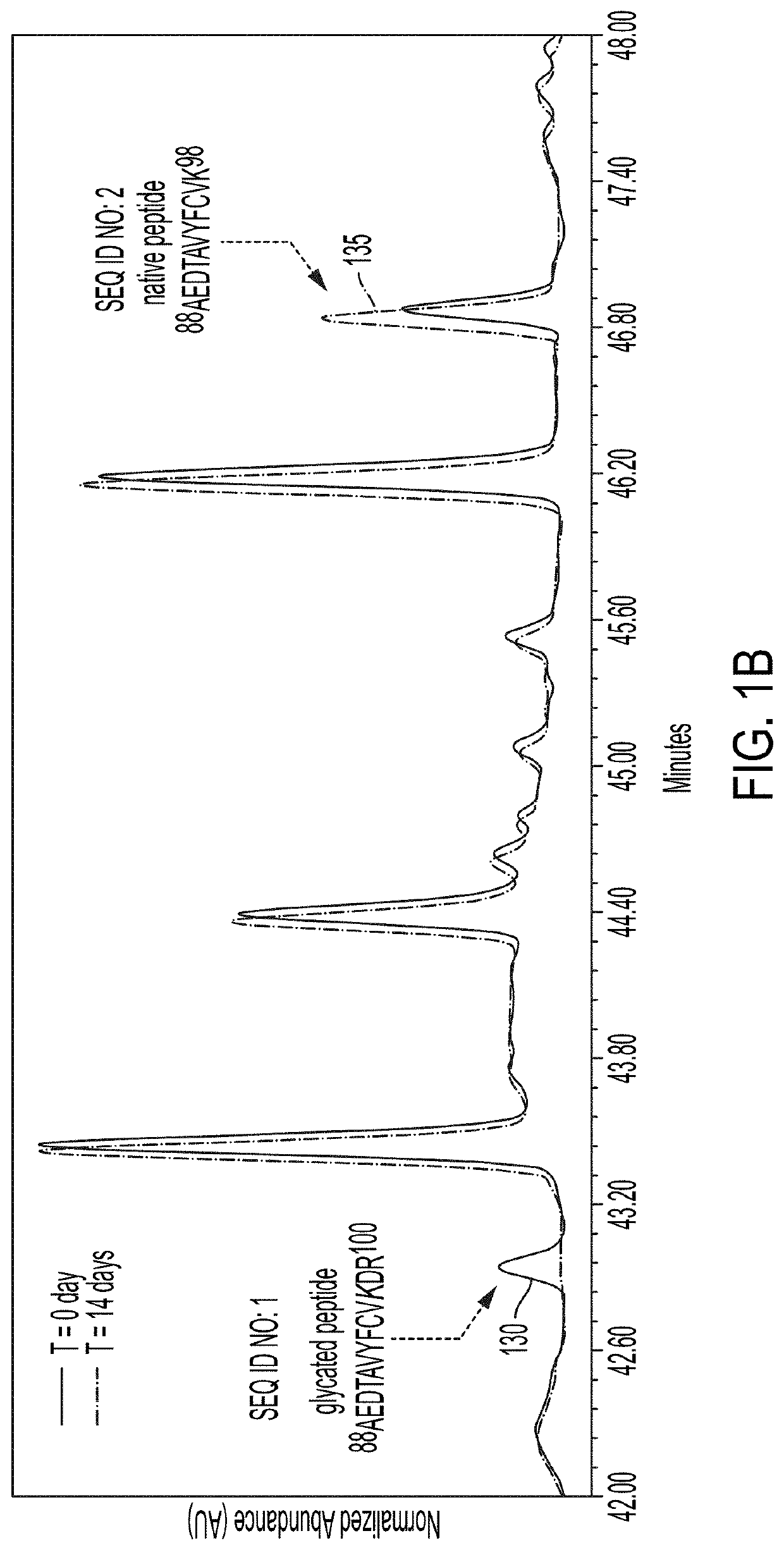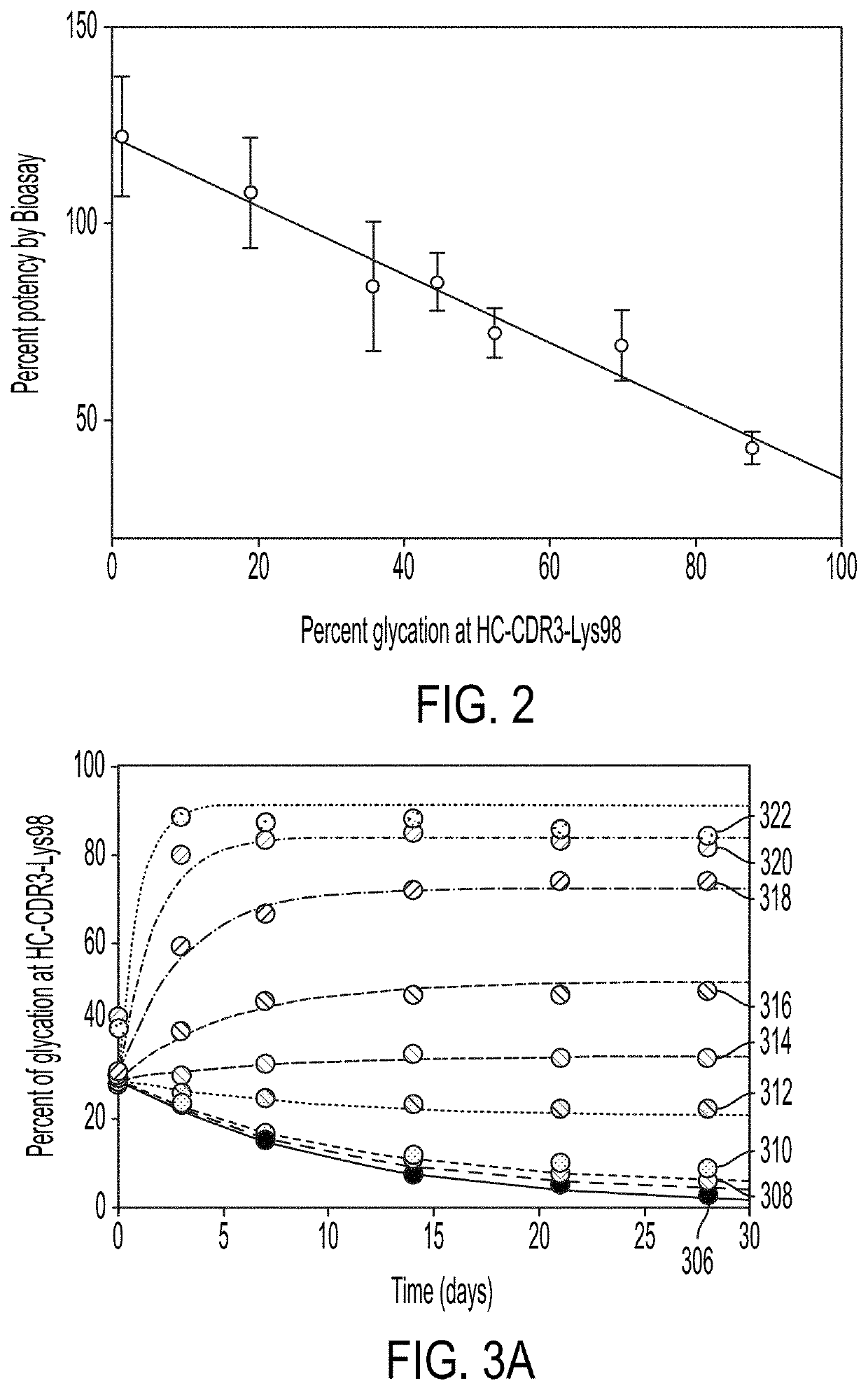Methods for Predicting and Modulating Glycation of a Protein
- Summary
- Abstract
- Description
- Claims
- Application Information
AI Technical Summary
Benefits of technology
Problems solved by technology
Method used
Image
Examples
example 1
riants Analysis of mAb-1 by CEX and LC-MS Peptide Mapping Reveal a Species with Reversible Glycation at HC-CDR3-Lys98
[0155]CEX was used to separate mAb-1 charge variants. Two major species eluted at 8.9 and 9.5 minutes and a number of minor species eluted earlier than 8.6 minutes and later than 10 minutes (FIG. 1A). The fractions of these two major species in neat mAb-1, eluting at 8.9 and 9.5 minutes, were approximately 27% and 47% of the total peak area, respectively. After incubating mAb-1 in 10 mM histidine, pH 6.0 and at 37° C. for 14 days, the relative amount of the species eluting at 8.9 minutes decreased and the relative amount of the species eluting at 9.5 minutes increased by approximately the same amount (refer to line 110, FIG. 1A), suggesting an ongoing reaction within the protein leading to the interconversion of the species eluting at 8.9 and 9.5 minutes, which may reflect the difference on their surface charge.
[0156]To understand the chemical nature of these two mAb-...
example 2
Glycation at HC-CDR3-Lys98 Correlates to Drug Potency
[0159]To determine whether the glycation at HC-CDR3-Lys98 interferes with biological activity, glycated and non-glycated forms of mAb-1 purified by semi-preparative CEX chromatography, were mixed at various ratios to generate mAb-1 samples with glycation level ranging from 1 to 88% (determined by LC-MS based peptide mapping) and subjected to a cell-based potency assay. The results indicated a linear and inverse correlation between the level of glycation at HC-CDR3-Lys98 and the potency with a higher level of glycation at HC-CDR3-Lys98 being associated with a lower level of drug potency (FIG. 2). In addition, the binding affinity to the corresponding antigen, as measured by Biacore, indicated that mAb-1 with 88% glycation has approximately two-fold decrease in association rates compared to mAb-1 with 1% glycation, resulting in about two-fold decrease in binding affinity (data not shown). This is consistent with the cell based poten...
example 3
ys98 Glycation Reaction Depends on the Concentration of Glucose in Solution
[0160]To understand the impact of glucose on the glycation at HC-CDR3-Lys98, 6.9 μM mAb-1 (˜1 mg / mL) was incubated with different concentrations of glucose from 0.3 to 111 mM at 37° C. for 28 days. The level of glycation in mAb-1 at the start of incubation was approximately 27% at HC-CDR3-Lys98. During the course of incubation, the level of glycation at HC-CDR3-Lys98 slowly decreased when solutions contained 3 mM glucose. At higher glucose concentration 6 mM), the free glucose binds covalently to the non-glycated HC-CDR3-Lys98, increasing the level of glycation over time until reaching the equilibrium (FIG. 3A).
[0161]The kinetics of glycation were analyzed with the first order models (Equation 5 and 6) by resolving three fitting parameters—the apparent rate constant, kapp, and amplitude, A, and the baseline, b, for each solution condition (Table 1), where the level of glycation at equilibrium was determined f...
PUM
| Property | Measurement | Unit |
|---|---|---|
| Temperature | aaaaa | aaaaa |
| Temperature | aaaaa | aaaaa |
| Temperature | aaaaa | aaaaa |
Abstract
Description
Claims
Application Information
 Login to View More
Login to View More - R&D
- Intellectual Property
- Life Sciences
- Materials
- Tech Scout
- Unparalleled Data Quality
- Higher Quality Content
- 60% Fewer Hallucinations
Browse by: Latest US Patents, China's latest patents, Technical Efficacy Thesaurus, Application Domain, Technology Topic, Popular Technical Reports.
© 2025 PatSnap. All rights reserved.Legal|Privacy policy|Modern Slavery Act Transparency Statement|Sitemap|About US| Contact US: help@patsnap.com



